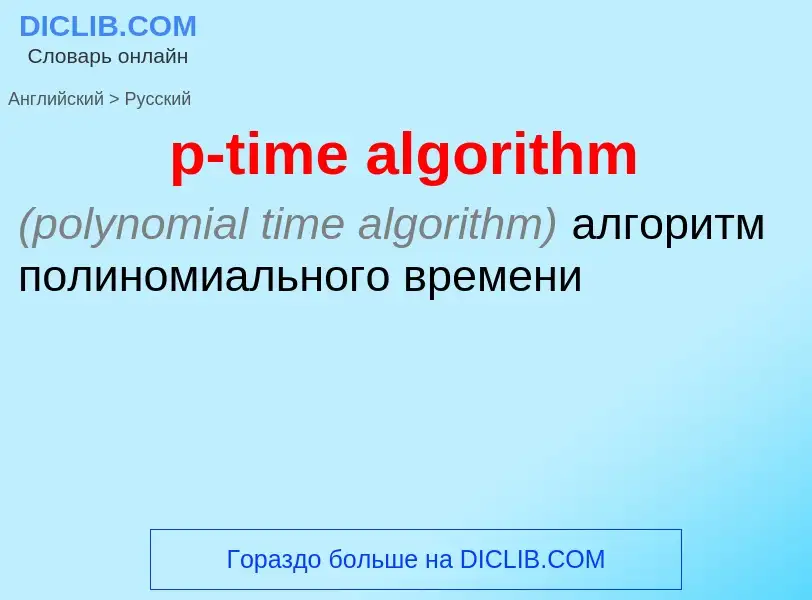Ingrese una palabra o frase en cualquier idioma 👆
Idioma:
Traducción y análisis de palabras por inteligencia artificial ChatGPT
En esta página puede obtener un análisis detallado de una palabra o frase, producido utilizando la mejor tecnología de inteligencia artificial hasta la fecha:
- cómo se usa la palabra
- frecuencia de uso
- se utiliza con más frecuencia en el habla oral o escrita
- opciones de traducción
- ejemplos de uso (varias frases con traducción)
- etimología
p-time algorithm - traducción al Inglés
INTEGER FACTORIZATION ALGORITHM
William's p plus 1 algorithm; William p plus 1 algorithm; Williams' p plus 1 algorithm; Williams' p+1 algorithm; P+1; Williams' p + 1 algorithm
p-time algorithm
(polynomial time algorithm) алгоритм полиномиального времени
algorithm
SEQUENCE OF INSTRUCTIONS TO PERFORM A TASK
Algorithmically; Computer algorithm; Properties of algorithms; Algorithim; Algoritmi de Numero Indorum; Algoritmi de numero indorum; Algoritmi De Numero Indorum; Алгоритм; Algorithem; Software logic; Computer algorithms; Encoding Algorithm; Naive algorithm; Naïve algorithm; Algorithm design; Algorithm segment; Algorithmic problem; Algorythm; Rule set; Continuous algorithm; Algorithms; Software-based; Algorithmic method; Algorhthym; Algorthym; Algorhythms; Formalization of algorithms; Mathematical algorithm; Draft:GE8151 Problem Solving and Python Programming; Computational algorithms; Optimization algorithms; Algorithm classification; History of algorithms; Patented algorithms; Algorithmus
algorithm noun math. алгоритм algorithm validation - проверка правильности алгоритма
algorithmic method
SEQUENCE OF INSTRUCTIONS TO PERFORM A TASK
Algorithmically; Computer algorithm; Properties of algorithms; Algorithim; Algoritmi de Numero Indorum; Algoritmi de numero indorum; Algoritmi De Numero Indorum; Алгоритм; Algorithem; Software logic; Computer algorithms; Encoding Algorithm; Naive algorithm; Naïve algorithm; Algorithm design; Algorithm segment; Algorithmic problem; Algorythm; Rule set; Continuous algorithm; Algorithms; Software-based; Algorithmic method; Algorhthym; Algorthym; Algorhythms; Formalization of algorithms; Mathematical algorithm; Draft:GE8151 Problem Solving and Python Programming; Computational algorithms; Optimization algorithms; Algorithm classification; History of algorithms; Patented algorithms; Algorithmus
<p style="margin-left:40px">математикаp>
<p style="margin-left:60px">алгоритмический методp>
Definición
Р
восемнадцатая буква современного русского алфавита; несколько видоизменённая буква Р ("рцы") кирилловского алфавита, восходящая к букве ρ греческого унциала. В глаголице - как бы перевёрнутая буква Ь. В кирилловском и глаголическом алфавитах числовое значение 100. Обозначает смычно-дрожащий переднеязычный нёбный согласный [р]. Фонологически различаются палатализованный (мягкий) [р'] (перед буквами "я", "ю", "и", "е", "ь" и в сочетании с последующим мягким согласным) и непалатализованный (твёрдый) [р] (перед буквами "а", "у", "ы", "э", на конце слова и в сочетании с последующим твёрдым согласным).
Wikipedia
Williams's p + 1 algorithm
In computational number theory, Williams's p + 1 algorithm is an integer factorization algorithm, one of the family of algebraic-group factorisation algorithms. It was invented by Hugh C. Williams in 1982.
It works well if the number N to be factored contains one or more prime factors p such that p + 1 is smooth, i.e. p + 1 contains only small factors. It uses Lucas sequences to perform exponentiation in a quadratic field.
It is analogous to Pollard's p − 1 algorithm.


![Alan Turing's statue at [[Bletchley Park]] Alan Turing's statue at [[Bletchley Park]]](https://commons.wikimedia.org/wiki/Special:FilePath/Alan Turing.jpg?width=200)




